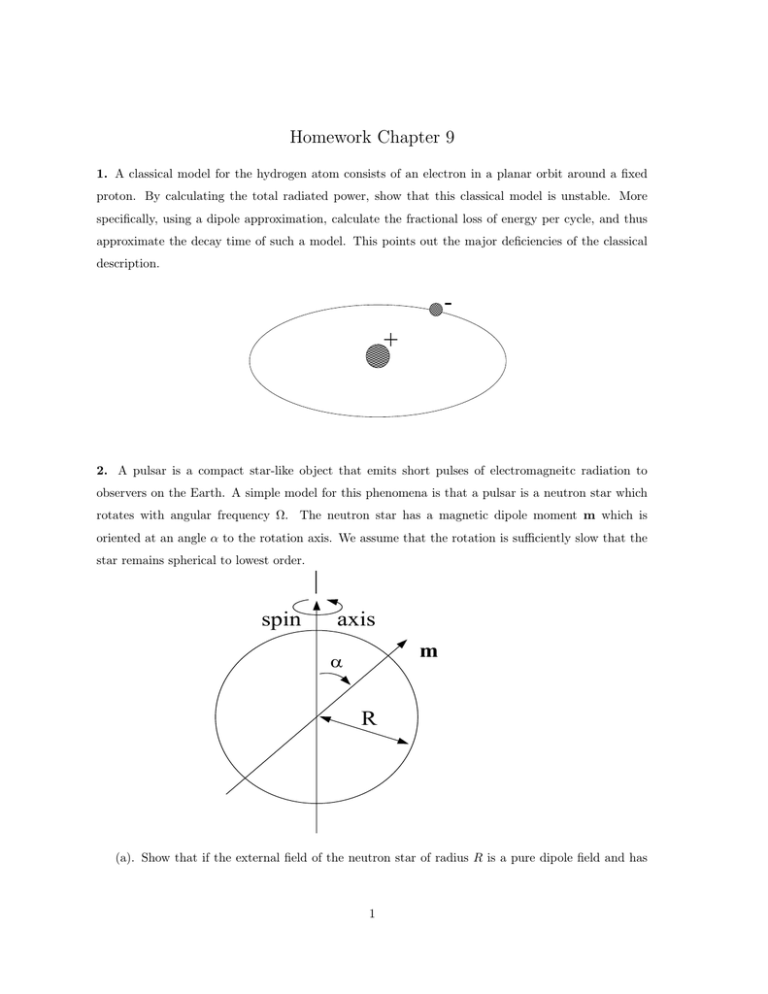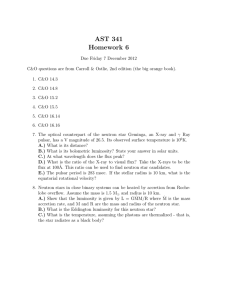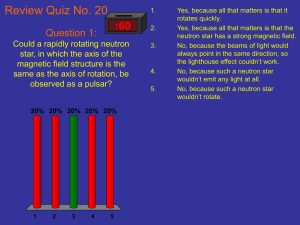Ω spin axis R
advertisement

Homework Chapter 9 1. A classical model for the hydrogen atom consists of an electron in a planar orbit around a fixed proton. By calculating the total radiated power, show that this classical model is unstable. More specifically, using a dipole approximation, calculate the fractional loss of energy per cycle, and thus approximate the decay time of such a model. This points out the major deficiencies of the classical description. + 2. A pulsar is a compact star-like object that emits short pulses of electromagneitc radiation to observers on the Earth. A simple model for this phenomena is that a pulsar is a neutron star which rotates with angular frequency Ω. The neutron star has a magnetic dipole moment m which is oriented at an angle α to the rotation axis. We assume that the rotation is sufficiently slow that the star remains spherical to lowest order. Ω spin axis m α R (a). Show that if the external field of the neutron star of radius R is a pure dipole field and has 1 value B0 at the magnetic pole, then |m| = 1 B0 R 3 2 independent of the internal field goemetry (hint, see Jackson, section 5.6). (b). Write general expression for: (i) the real time-dependent magnetic dipole moment; (ii) the asymptotic (far-field) electric field and a distant observation point x; and (iii) the asymptotic magnetic field at x. (c). Find the instantaneous (not time-averaged) Poynting vector at x. Discuss the time dependence of the signal received by a detector on Earth. (d). Find the rate of energy loss of the neutron star due to radiation. Given that the energy that is lost originates in the rotational kinetic energy of the neutron star of moment of inertia I, find the equation of motion for Ω(t). Apply this equation to the pulsar in the crab nebula, for which presently − 1 dΩ = 4.02 × 10−4 yr−1 Ω dt and for which it may be assumed that the original value of Ω was much larger than the present value. Using this, calculate the age of the crab pulsar in the magnetic dipole model. Compare this to the observed age (the crab nebual is a relic of a supernova explosion observed on earth in 1054 AD). (e). Based on models of neutron star structure, one may take the crab pulsar to have R = 12 Km.. Given the observed period of the pulsar (0.0331 sec.) and its observed total energy output (≈ 5 × 10 38 ergs/sec.), estimate the surface magnetic field at the magnetic pole of the pulsar. Compare with the typical surface field of 100 gauss in a normal star with R = 106 km.. Discuss this comparison and how it relates to the ideas that neutron stars are collaped remnants of normal stars and that magnetic fields are frozen into the highly conducting surface of a star. 3. A charge −q is located at each end of a line rotating with constant angular velocity about a perpendicular axis through its center. A charge +2q is fixed at the center. Calculate the components of the quadrupole tensor and find the fields in the far-field region, the angular distribution for the radiation, and the total power radiated (all in the long-wavelength approximation). Express your results in terms of spherical polar coordinates relative to the rotation axis. 2 ω0 -q -q 2q 4. A disc of radius a is illuminated by a point source lying on its symmetry axis a distance d 0 behind its plane. The resulting wave is observed on the symmetry axis a distance d 0 in front of its plane. Use the Kirchhoff formulation of scalar diffraction to study this problem in the limit ka À 1. a d0 d’ (a). Assuming that d0 = d0 , find the amplitude at d0 and verify that the correspoinding intensity varies like I(d0 ) = 1 2 2 I0 d0 /(a2 + d0 ) 4 where I0 is the incident intensity at the edge of the disc. Discuss this result. (b). If the disc is replaced by a complementary circular hole of radius a in an infinite screen, find the corresponding amplitude at d0 . If d0 À a, verify that the resulting intensity is given approximately by ¡ ¢ I(d0 ) = I0 sin2 ka2 /2d0 . Discuss this result. Explain carefully how Babinet’s principle holds (c). Repeat parts (a) and (b) in the limit d0 → ∞, keeping d0 fixed. This corresponds to the transformation from Fresnel illumination to Fraunhofer illumination. For the disc, verify that its effect disappears in the limit d À a. 3 5. 1. Given a normally incident wave of frequency ω calculate the diffrection pattern produced by an opaque screen with an aperture in the shape of a narrow ring of radius a and width ² in the Fraunhofer limit of the scalar Kirchoff approximation. Assume that k² ¿ 1 where k = ω/c. 2. The correct answer to the first part of this problem also yields the solution to the diffraction pattern involving a quite different set of apertures. What is this other set of apertures? a ε 6. Prove Babinet’ principle. That is, show that Z 1 eik|x−x0 | ψ(x) + ψ(x) = − d2 x0 n0 · (ψ(x0 )∇G(x, x0 )) = 4π σ̄+σ |x − x0 | (1) 7. Show, using symmetry arguments that a oscillating sphere does not radiate (we did this part in class). Now apply these arguments the spheroid to interpret the nodes in its radiation pattern. 4

